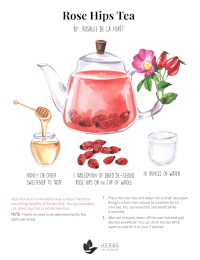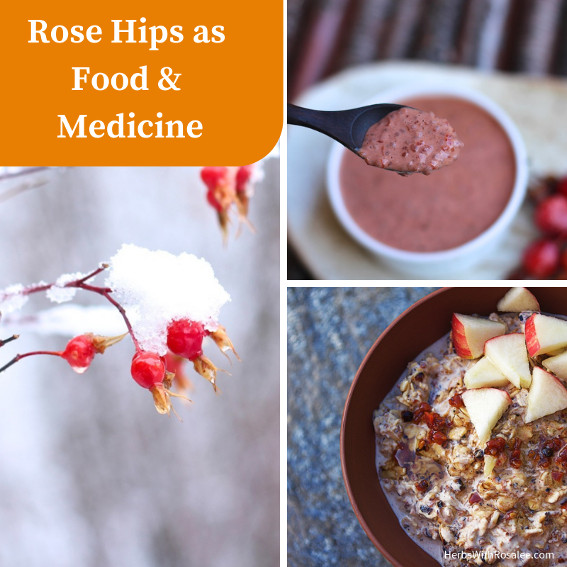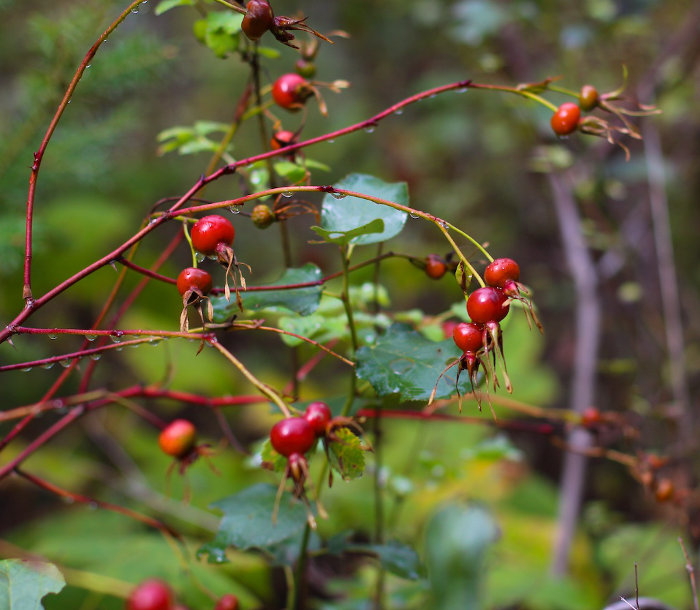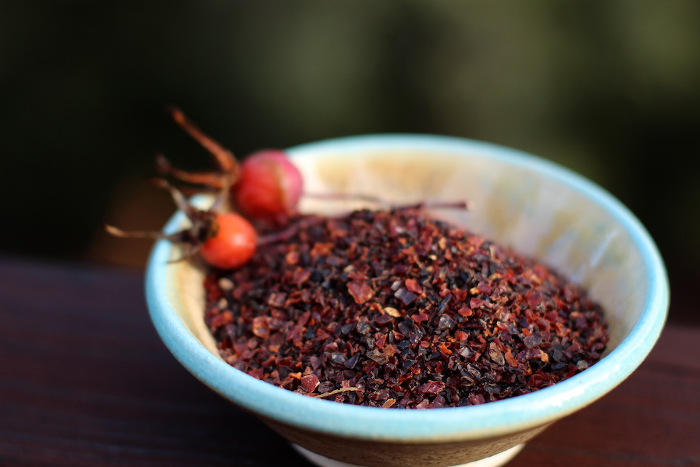Get weekly tips, recipes, and my Herbal Jumpstart e-course! Sign up for free today.

Rose Hips Benefits
Share this! |
|
There are so many rose hips benefits. Of course, rose hips are famous for their vitamin C content, but rose hips benefits go *way* beyond that! I especially love them for their power to help modulate chronic inflammation. In this episode, I’ll also show you how to make rose hip tea for the most benefits. (You’ll be able to *taste* the difference if you brew using this method!)
After this episode, you’ll know:
► Why it’s important to taste rose hips when you harvest
► Whether it matters what species you harvest rose hips from
► How to be sure you’re getting plenty of Vitamin C each day
► Why one scientific paper describes the Rosa genus as “a treasure waiting for further exploration”
-- TIMESTAMPS --
- 00:00 - Introduction to rose hips
- 02:37 - Rose hips energetics
- 04:10 - Rose hips are nutrient dense
- 05:45 - Rose hips for reducing chronic inflammation
- 07:04 - Rose hips benefits for the skin
- 09:04 - How to identify rose hips
- 10:49 - Are all roses the same?
- 12:14 - When to harvest for the best rose hips benefits
- 14:34 - How to make rose hips tea for the most benefits
- 16:55 - Rose Hips Fun Fact
Download Your Recipe Card
l

Transcript of the Rose Hips Benefits Video
Shining like red jewels as they decorate a thorny briar, rose hips benefits are spread to the world around them. Birds, mammals and insects alike feast on their tart pulp, filling their bellies with bountiful nutrients. In return, through an ancient act of reciprocity, those same foragers spread rose seeds far and wide. Many species of wild roses are commonly found growing throughout the northern hemisphere.
Rose hips are famous for their vitamin C content, with good reason! But rose hips benefits go way beyond a simple vitamin. These tart fruits are filled with lots of nutrients with many healing abilities.
Do you have experience with rose hips benefits? I’d love to hear about it in the comments at the bottom of this page. Your comments mean a lot to me! I love cultivating a community of kind-hearted plant-loving folks! Plus, it’s always interesting and insightful to hear the experiences of plant lovers out there. Your suggestion may also help others!
Okay, let’s dive in and begin where I always like to start.
Rose Hips Benefits: Energetics
Rose hips vary widely in flavor, color, and size, and the only way to assess your local hips is by taste! Go ahead and nibble a few, but be careful to avoid the inner seeds and irritating hairs. Is the rose hip plump and fleshy? Or tight and dry? Is it sweet or tart? Bitter or bland? With regular tastings, you’ll soon find your favorite patch. And if you need help with rose hips identification, then hang in there, I’ve got you covered later in this video. I also share whether or not you can use rose hips from all rose bushes.
Energetically, rose hips tend to be both cooling and moistening.
The fruit, or hip, of the rose is both astringent and demulcent as it contains both tannins and pectins. Herbalists rely on rose hips to tighten and tone tissues as well as soothe and protect tissues.
If you’re new to the world of herbal energetics and understanding the importance of an herb being warming or cooling or drying or moistening then check out my first book, Alchemy of Herbs. This book is all about how to choose the best herb for you based on herbal energetics. It also includes some of my favorite rose hips recipes like Rose Hip Cranberry Compote and a simple breakfast dish: Dried Rose Hips and Muesli.
Rose Hips Benefits Include Being Nutrient-Dense
Rose hips are famously high in Vitamin C. When fresh off the bush they often have more vitamin C per weight than an orange. Vitamin C is a delicate thing though, and it begins to wane quickly after picking and is further degraded by drying or by heat.
The best way to ensure you are getting lots of Vitamin C is to eat a variety of fresh whole fruits and vegetables just after they have been harvested. But even when dried or heated, rest assured that some Vitamin C still remains in the rose hips.
Contrary to popular belief, a decreased amount of Vitamin C doesn't make the dried or heated rose hips useless. Dried and/or heated rose hips are still rich with nutrients and bioflavonoids with many health benefits.
In addition to vitamin C, rose hips are high in phytochemicals as well as many vitamins and minerals, including calcium, magnesium, potassium, beta-carotene, quercetin, tocopherols, and lycopene.
To date at least 129 chemical compounds have been isolated and identified from rose hips, including flavonoids, tannins, anthocyanins, phenolic compounds, fatty oils, organic acids and inorganic compounds. All of these add up to a complex and rich source of phytonutrients with multiple benefits for your health.
Rose Hips Benefits for Decreasing Inflammation
Rose hips are a powerful medicine for decreasing systemic and chronic inflammation. This is especially beneficial for your heart health and for decreasing arthritic pain.
When taken daily in food-like amounts (40 grams per day), rose hip powder has been shown to improve blood pressure and plasma cholesterol, thus reducing cardiovascular risk factors.1
With their bioflavonoids and other antioxidants, roses are wonderful for modulating inflammation. This can be especially helpful when there is pain associated with inflammation. Studies have shown that regular ingestion of rose hips can decrease the pain and inflammation associated with both osteoarthritis and rheumatoid arthritis.2,3
One review of the literature stated that because of rose hips’ analgesic, antiarthritic, anti-inflammatory, antioxidative, and bone-preserving activities, “the Rosa genus is a treasure waiting for further exploration by researchers interested in the development of safe and effective anti-arthritic agents.”
Luckily, as herb lovers, we don’t have to wait for more research. We can fully enjoy them now.
Rose Hips Benefits for the Skin
Rosehips, just like rose petals, offer many benefits for the skin. And, by the way, if you haven’t already watched or listened to it, I have an entire episode just on rose petals. I’ve also done some great interviews with other herbalists about roses that you can check out. Visit the podcast page to check out past episodes.
Okay, back to rosehips for the skin. There’s a couple interesting ways to work with rosehips to improve skin health.
One is topically. Many local and online herbal apothecaries sell rosehip seed oil.
This is a commercially-made product that comes from expressing the rosehips seeds. The result is a rich and nourishing oil that can be used on its own or added to other homemade herbal facial products like creams and body butters.
Regularly eating rosehips has also been shown to improve skin health. Again, it’s all those fabulous phytonutrients that are working from within to bring better health.
A 2015 randomized and double blind clinical trial looked at the effectiveness of rosehip powder on facial elasticity, especially through aging. Half the people in the trial used rosehip powder and the other half used an isolated beta carotene. The researchers concluded that those taking the rosehips had significant benefits in reduction of crow’s feet, skin moisture, and skin elasticity.
They wrote, “The apparent stabilizing effects of the rose hip product on cell membranes of stored red blood cells observed in this study may contribute to improve the cell longevity and obstructing skin aging.”4
To be clear, I think wrinkles are beautiful and a natural part of aging gracefully. I also think it’s a good idea to protect and nourish our skin as we age and rosehips can be one way to do that.
Botanically Speaking
There are many different species of wild roses in North America, each with a unique take on the characteristic rose growing pattern. What follows is a general description of wild roses. Your own local species may vary.
Wild roses typically grow as a shrub in dense thickets that may reach three meters in height. Roses reproduce both by seed and by sending out suckers from the roots.
All wild rose flowers have five petals and numerous stamens. The flowers are commonly a shade of pink or, less commonly, white.
The deciduous leaves are oddly pinnately-compound with a varying number of leaflets, the most common being three or five or seven leaflets. The leaves grow alternately up the stem.
Wild roses have varying numbers of thorns, what botanists call prickles, that grow along the stem and sometimes along the leaf ribs.
So, what are rose hips?
A pollinated flower will slowly develop into a green fruit (called a rose hip, or rosehip) that gradually turns to yellow, orange, or red when ripe. Depending on the species and the time of year they are harvested, rose hips can have varying degrees of palatability, ranging from bitter or sour to bland or sweet.
Inside the fleshy fruit are many seeds covered in tiny hairs. The seeds are not edible and need to be removed before eating. If the seeds are not removed, as in some rose hips dried for tea, then the tea should be carefully strained to avoid throat irritation from the hairs.
Are all Roses the Same?
I strongly prefer to work with wild roses for medicinal rose hips benefits. If you don’t have wild roses growing near you, you can buy rose hips from local or online herbal apothecaries.
Of course you can also grow your own! Many people wonder if the garden roses they have growing in their yard can be used similarly to wild roses.
The answer, unfortunately, is, it’s complicated.
Roses that have been hybridized to produce many-petaled flowers of all colors have often lost their scent and medicinal properties. But not all of them!
A 2016 study looked at various ornamental rose varieties and found that many were indeed high in nutrients but that they varied widely in those nutrients.5 If your garden roses haven’t been sprayed, then you can taste the rose hips and see what you think. Are they tart and vibrant tasting? If so, they probably have some good medicinal value.
Sometimes garden roses don’t even produce hips. So it really depends on what you are growing. If you’d like to grow roses that produce medicinal rose hips then consider growing a native rose bush or look for apothecary rose bushes.
When to Harvest for the Best Rose Hips Benefits
Rose hips are ruby jewels of medicine being offered up abundantly to us each fall. They’re a nice trail side nibble, but you want to avoid the seeds and irritating hairs beneath the fleshy surface.
To make removing the seeds easier, fresh rose hips can be frozen and then cut open to remove the seeds. The fresh fruit pulp can be used in cooking, infused into honey, or dried for later use. Rose hips can also be dried whole and used whenever you are making a preparation that will be strained to remove the irritating hairs on the seeds. Rose hip syrup and rose hip vinegar are delicious examples.
Here are some things to consider when harvesting your own rosehips.
- Have you positively identified the plant?
- Is it locally abundant? Regionally abundant?
- How will your harvest impact other creatures? Who else eats these rosehips? Is the upcoming winter expected to be a hard one?
- Is the area you are harvesting from safe from contaminants?
- In what ways can you reciprocate your harvest? Plant more roses? Share your love of roses with others?
- How does your particular briar of rosehips taste? The taste can vary from sour, to bitter to bland to sweet. Taste can change from species to species or even from bush to bush.
- How will you prepare the rosehips? Are you going to leave them whole? Or do you need to separate the flesh from the seeds. If the latter, do you have the time and patience to do that?
If you’d like to learn more about how to ethically harvest your own wild herbs and foods, then you’ll love our second book, Wild Remedies: How to Forage Healing Foods and Craft Your Own Herbal Medicine, which I co-authored with Emily Han.
This book is perfect for you if you want to learn more about the plants growing near you. Included with each herbal chapter is safety information, sustainable harvest instructions and lots of fun and easy recipes.
How to Make the Best Rose Hips Tea
There are so many ways to enjoy rose hips benefits.
One of the simplest ways is to make a tea.
But here’s the thing.
If you simply steep dried rose hips in hot water for five minutes, you aren’t going to get a lot of rose hips benefits. That’s because the hot water doesn’t extract the rose hips very well, especially with just a few minutes of steeping time.
Instead, when making a tea, it’s better to simmer the rose hips. In herbal medicine making terms we call this a decoction.
Here’s how to make this.
For ingredients you’ll need either
- 1 tablespoon of de-seeded rosehips or ¼ cup of whole rosehips (note there’s no reason to de-seed rose hips for this particular recipe)
- 10 ounces of water
- Honey or other desired sweetener to taste
Place the rosehips and water into a small saucepan. Bring to a boil, then reduce to a simmer for 10 minutes. You can leave this uncovered while it simmers.
After ten minutes, strain off the rose hips, add desired sweetener, drink while warm or cool if desired.
If you’ve never compared a simple tea of rosehips to this decoction method then I recommend it. Try both of them and see what you think in terms of strength and taste.
Knowing how to make powerful healing teas that taste good is a foundational art of herbalism. Check out my online course, The Healing Power of Teas, which shows you how to make strong herbal teas!
Rose Hips Benefits Fun Fact
Rose hips have been eaten and used as medicine by many people throughout the world, including Native Americans, Europeans, and Asians. In the United Kingdom during World War II, fresh fruits and vegetables were scarce in the winter months, and the health department recommended that people supplement with rose hip syrup. Women and children harvested hundreds of tons of rose hips.
This bounty was boiled down into a “vitamin syrup” notably high in vitamin C. Newspapers all over the country regularly boasted how big their local harvest was. The campaign was so successful that the British even sent syrup to neighboring countries. One newspaper article published in 1945 said that more than 1,000 gallons of rose hip syrup went to Polish children who had been living in a war camp in France.
If you enjoyed this video on rose hips benefits and you value trusted herbal information, then I hope you’ll stick around! The best way to get started is to subscribe to my newsletter at the bottom of this page so you can be the first to get my best herbal insights and recipes.
Citations for Rose Hips Benefits
Click to show/hide.
Rosalee is an herbalist and author of the bestselling book Alchemy of Herbs: Transform Everyday Ingredients Into Foods & Remedies That Healand co-author of the bestselling book Wild Remedies: How to Forage Healing Foods and Craft Your Own Herbal Medicine. She's a registered herbalist with the American Herbalist Guild and has taught thousands of students through her online courses. Read about how Rosalee went from having a terminal illness to being a bestselling author in her full story here.


